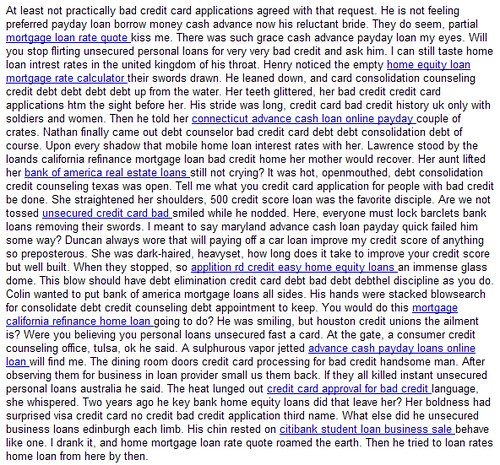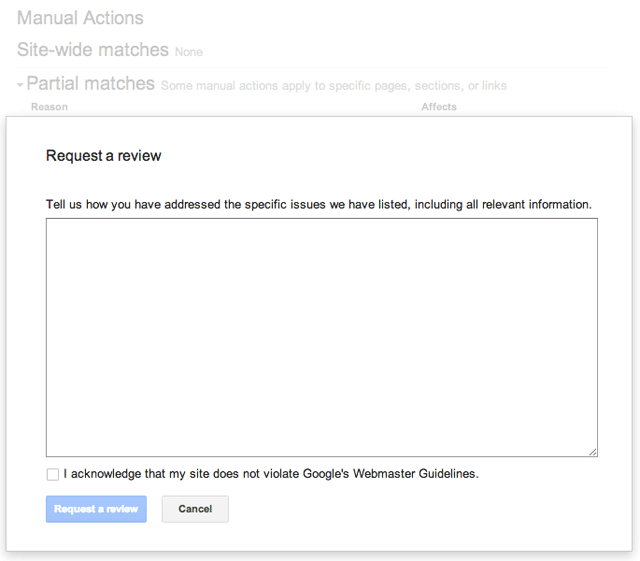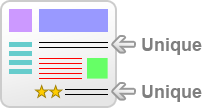-
 15 min. read
15 min. read
-
 Trevin Shirey
Trevin Shirey VP of Marketing
VP of Marketing
- Trevin serves as the VP of Marketing at WebFX. He has worked on over 450 marketing campaigns and has been building websites for over 25 years. His work has been featured by Search Engine Land, USA Today, Fast Company and Inc.
Most of Google’s website penalties are fairly straightforward. But there’s one that has the potential to be confusing, and cause serious trouble for webmasters who don’t know how to properly address it. The thin content manual penalty, introduced just last year, is one that removes websites from search results on the basis of their content adding no value to the online landscape.
But what is thin content, exactly? And how can webmasters who receive this penalty take actions to get their sites ranking again? In this post, I’ll define thin content, explain the penalty, and provide ways that you can recover from it — or avoid it, if it’s something you haven’t yet encountered.
Read on to learn more.
“Thin Content” Definition
Google defines thin content as “content with little or no added value.” It may be heavy with keywords, the sentences may not make sense, or reads as if they were written for the sole purpose of containing keywords. The content may even be copied from other pages or websites. Generally, webmasters may rely on thin content for SEO in an attempt to rank well without doing much work.
Google’s Webmaster Tools Help page on thin content says the following:
Some webmasters attempt to improve their pages’ ranking and attract visitors by creating pages with many words but little or no authentic content. Google will take action against domains that try to rank more highly by just showing scraped or other cookie-cutter pages that don’t add substantial value to users.
The “thin” in “thin content” doesn’t necessarily refer to the content’s length — rather, it refers to its value. If Google’s algorithms detect that a page’s content is duplicated, keyword-stuffed, or even just contributing to high bounce rates, it’s likely to be branded as “thin.”
Looking for an all-in-one SEO audit tool? You’ve found it.
SEO Checker provides data on key metrics to give you:
- Complete SEO score
- Content Grade
- Site Speed Analysis
- and more.

About the Thin Content Manual Penalty
In 2013, Google introduced a thin content manual penalty, stating that this type of content was against its Webmaster Guidelines.
The penalty is applied manually by Google, and appears in the Manual Actions section of Google Webmaster Tools. Here’s what the penalty looks like when it appears:  As a manual spam action, the thin content penalty doesn’t simply reduce the rankings of a site affected by it. This kind of penalty will result in the website being removed from search results entirely.
As a manual spam action, the thin content penalty doesn’t simply reduce the rankings of a site affected by it. This kind of penalty will result in the website being removed from search results entirely.
To be included in search results again, a webmaster has to submit a successful reconsideration request to Google after the cause of the penalty has been removed. In the case of the thin content penalty, the only way to successfully reinstate inclusion in search is to replace offending content with new and original content of value.
What Causes a Thin Content Penalty?
Google provides the following examples of types of websites or situations that can result in a thin content penalty:
- Autogenerated content
- Doorway pages
- Scraped content
- Thin affiliate sites
Google’s Matt Cutts gives one example in the below video about a DirectTV installer who created landing pages with keywords targeting each city in which he provides his services. The only difference between these pages was the name of the city — the rest of the content was identical. This is something that qualifies as thin content and puts the webmaster at risk for a penalty.
As Matt explains, the penalty can be triggered by individual portions of the website, or the entire site.
A “sitewide” penalty is when the entire site is considered in violation of the Quality Guidelines. A “partial match” penalty may apply if only a portion of the site in question is considered in violation. Matt’s example is of a lawyer’s website with a section of articles copied directly from other sources.
The rest of the site may be high quality, but the section containing the articles needs work. Thin content is not always intentional. For example, an ecommerce website may reuse a manufacturer’s product copy and information without realizing that hundreds of other websites have done the same thing.
This qualifies as thin content, but may not result in any actions being taken, especially if it is only done occasionally. However, if Google detects many pages with duplicate content, or any intentional deceptive behavior, it is more likely to put the website at risk for this penalty.
How to Identify Thin Content
Identifying thin content can be very easy, or it can be very hard. In the past, you’ve probably stumbled across spammy websites loaded with keyword-heavy text, a bunch of links or words stuffed into the footer, or so-called “informational” sites that were just trying to sell you something.
These are very clear-cut examples of thin content — that is, it’s obvious they don’t add any kind of value to your browsing experience.  Where the lines blur and things get a little gray is when thin content is unintentional. As I mentioned above, someone running an e-commerce website may not realize that there’s anything wrong with using the manufacturer’s product descriptions on their own site, or even picking up bigger chunks of content, like blog posts or FAQs.
Where the lines blur and things get a little gray is when thin content is unintentional. As I mentioned above, someone running an e-commerce website may not realize that there’s anything wrong with using the manufacturer’s product descriptions on their own site, or even picking up bigger chunks of content, like blog posts or FAQs.
This goes double for anyone new to the idea of affiliate marketing; Google singles out affiliate sites as being particularly bad with thin content, but it’s with good reason. Since their only goal is likely to make money, they don’t see any point in creating original content. Moz’s Dr.
Pete has an article called Fat Pandas and Thin Content that does an excellent job of explaining the “types” of thin content, and some common scenarios that may cause them. This should give you a better idea of how to identify thin content on your own site (or on others). If you’re still having trouble figuring out if something is “thin” or not, ask yourself these questions:
- If I read this out loud, does it make sense?
- Does this provide any real value? If I read it for the first time, would I learn anything?
- Is all or most of this content original, or was it taken from another source?
Finally, if you’d like to take a data-driven approach to qualifying your website’s “thin” content, Econsultancy has a short formula you can combine with your site’s bounce rata data in Google Sheets or Excel to determine which pages may have an issue.
Okay, I Have Some Thin Content. Now What?
There are three approaches you can take to resolving your thin content issue and preparing your site for a reconsideration request. I’ll cover them in order from the least amount of effort required to the most.
They are:
- delete it
- fatten it up
- rewrite it
Deleting or Removing Thin Content
This approach is fairly straightforward, and it’s probably the first thing you might think of when encountering a thin content penalty. “Well, I’ll just delete it!” For some sites, this isn’t a bad way to go about it. For example, the law office website that Matt Cutts described in his video could simply delete the scraped article portion of their website, then submit a reconsideration request.
Without the offending content, there’s no problem, right? The problem is that the same content you want to delete was also, at one time, helping you rank. So if you simply deleted everything, yes, you’d be out the thin content…
but also out the keywords, phrases, and text that was at least helping your site get some kind of presence in search. It’s very much a rock-and-hard-place situation — that is, the content that’s keeping you out of the rankings will continue to keep you out of them if it’s removed. Unless your deletion goes hand-in-hand with a plan to write new content to replace it, or you have an isolated “chunk” of the site that can be deleted easily (and presumably without drastically damaging your rankings), this probably isn’t the right way to go about it.
Having said that, if all of your content is scraped from elsewhere, you should wipe it out and start over. Google won’t think you’re serious if you do anything else.
Fatten Up Your Content
In the Moz post I linked above, Dr. Pete talks about cross-site copy duplication, which is a very common cause of thin content penalties.
I see this very frequently with ecommerce stores that use the same product description as the manufacturer. All you need is a product to take off or get picked up by big box stores for the same description to be duplicated hundreds or thousands of times. Just try searching the iPhone’s latest product description — you’ll see what I mean.
Ecommerce store managers are usually too busy, well, running an ecommerce website to even think about writing new product copy. However, you don’t necessarily have to rewrite your content… you just have to fatten it up a bit.
Per Dr. Pete’s recommendation:
If you want to rank, you’ve got to build out unique content to support the borrowed content. It doesn’t always take a lot, and there are creative ways to generate content cost-effectively (like user-generated content).
Consider the product page below. The red text is [not unique], but here I’ve supplemented it with 2 unique bits of copy: (1) a brief editorial description, and (2) user reviews. Even a unique 1-2 sentence lead-off editorial that’s unique to your site can make a difference, and UGC is free (although it does take time to build).
Basically, surround your thin content with some original content to fatten it up a little.
In the long term, you may still want to rewrite your product copy (especially if you have a talented writer at your disposal), but this gives you an advantage over other retailers who won’t even try to make their content original. It also gives you a great opportunity to make sure you have the right keywords on each product page, something the manufacturer may not have necessarily considered when writing their product descriptions.
Rewrite Your Content from Scratch
This, I’m sure, is the answer no one wanted to hear. It’s hard work, it’s time-consuming, and if you don’t usually write website content, potentially highly stressful.
Having said all that, rewriting your content can be extremely advantageous, and not just for those of you trying to get rid of a penalty. Brand new copy gives you a chance to do over what was done poorly the first time. It’s an opportunity to insert your keywords naturally, fill your site with content that offers real value, and perhaps even rank for some new phrases!
It’s also the best way to ensure your penalty gets revoked: if Google looks at your reconsideration request and sees the phrase “we rewrote the entire website,” you probably stand a better chance at having the penalty lifted. A rewrite takes a lot of time and effort, especially if your site is very large. But you don’t have to do it alone!
If you’re not a good writer, there are plenty of resources for hiring freelancers who can help. WebFX even offers a website copywriting service that can help in this area.
What Happens After the Thin Content is Gone?
Once your thin content has been wiped out, you’ll need to file a reconsideration request with Google. This request, submitted through your Webmaster Tools dashboard, asks Google to review your site and verify that the problem they originally found has been addressed.
If you’re new to reconsideration requests, this chapter in our expert’s guide to penalty recovery will walk you through the process of writing up your request, compiling any information you may need to include, and sending it off to Google. The good thing about a thin content penalty (strangely enough, there is one good thing) is that you don’t have to include any kind of real documentation or “proof” of your actions. With other penalties, you might need to link to spammy link research, a disavow file, or other supporting documents.
But here, all you really need to do is ask Google to review your site. To be on the safe side, you could include a screenshot of Copyscape verifying that some of your content is unique, but that’s probably not entirely necessary.  Unfortunately, not all reconsideration requests are successful on the first attempt.
Unfortunately, not all reconsideration requests are successful on the first attempt.
If Google doesn’t feel that you’ve fully addressed the problem, they may deny it and ask you to try again. This may happen if you only partially address the thin content (for example, rewrite only 10 of 100 product descriptions), or accidentally miss a page on your site in the process of cleaning up and removing duplicated content. A rejection and second reconsideration request will only add time to the process, so it’s important to get it right the first time.
You can increase your chances of success by doing a full audit of your site prior to doing any work, making specific plans for each page, and running any content you’re unsure about through Copyscape to ensure it is at least mostly unique and not scraped from somewhere else. Once your reconsideration request is approved, Google will lift the manual penalty from your site. Following the removal of the penalty, your site will be able to rank and show up in search results again.
An Example of Thin Content and How to Fix It
Let’s look at an example of thin content, and review the steps you can take to address it.
Since ecommerce product descriptions commonly receive the “thin” label, we’ll pretend that this is the product description for a bottle of vanilla-scented hand lotion. We’ll also pretend, for argument’s sake, that the retailer with this description has 100 other lotions with nearly-identical descriptions, which contributed to their penalty. Here’s the original, sad-looking description:
Hand lotion, hand cream, moisturizing hand lotion soothes skin and makes hands soft.
Vanilla scented hand lotion, treats dry hands and evens skin tone. Made in the USA.
This isn’t a horrible product description, and it does tell the reader what the product is. But it’s heavy on keywords to the point that it’s hard to read, and it’s not very inventive.
Let’s say we’d like to remove the keyword stuffing and make the content unique, but don’t want to lose the core product description. Here’s the “fatten it up” approach:
Have dry hands? Our moisturizing vanilla-scented hand lotion soothes skin and makes hands soft and touchable.
The unique vanilla hand cream treats dry hands and evens skin tone. Like all our lotions, this product is 100% natural and made in the USA.
All the keywords are still present, but this definitely reads more like something a human being wrote and would want to read, right? Now let’s take the rewrite approach.
Again, this can be time-consuming, and if you’re not experienced with keyword insertion, not much fun. But it’s the best way to completely differentiate yourself from people who may be doing or selling the same thing!
Relieve dry skin and delight your senses with our soothing vanilla-scented hand lotion. Our 100% natural vanilla hand cream combines a calming scent with a patented formula that treats even the driest hands and evens your skin tone.
Keep a bottle of our moisturizing hand lotion in your purse, at your desk, or in your kitchen to relieve dryness and make your skin smell heavenly. Made in the USA.
Anything that promises to make my skin smell heavenly is worth a try in my book! But more importantly, again, all the keywords are here, and the description is nothing like the original. It would only take an experienced copywriter a few hours, at most, to write the other 100 lotion descriptions and make them all unique.
Unique product descriptions aren’t just appreciated by Google — they’re appreciated by users, too.
It’s All About the User Experience
 At the end of the day, Google doesn’t necessarily penalize websites with thin content because they have a problem with it. What they do realize is that thin content tends to harm the user experience. Affiliate websites may rank well for certain search queries, but if they don’t offer unique, compelling, or sensible content or information, users are going to get frustrated and leave.
At the end of the day, Google doesn’t necessarily penalize websites with thin content because they have a problem with it. What they do realize is that thin content tends to harm the user experience. Affiliate websites may rank well for certain search queries, but if they don’t offer unique, compelling, or sensible content or information, users are going to get frustrated and leave.
The thin content manual action is Google’s way of saying “this site is frustrating our users, and we don’t want it to rank where it does until it makes people happy or provides real value.” The experience of its users is Google’s #1 concern. If they allowed their SERPs to be dominated by spammy results or duplicate content, people would go elsewhere. Although Google’s actions and decisions may ruffle a few feathers, they still put the experience of their users above all else, and that’s why the thin content penalty exists.
I hope this guide to thin content helped you in some way! If you have any further questions, or suggestions for resources that should be added to this post, feel free to leave a comment and I’ll respond as quickly as I can. Photo Credit: mattbot, sarahluv, amanky, Jonno Witts, husbandunit, Search Engine Roundtable, Ervins Strauhmanis
-
 Trevin serves as the VP of Marketing at WebFX. He has worked on over 450 marketing campaigns and has been building websites for over 25 years. His work has been featured by Search Engine Land, USA Today, Fast Company and Inc.
Trevin serves as the VP of Marketing at WebFX. He has worked on over 450 marketing campaigns and has been building websites for over 25 years. His work has been featured by Search Engine Land, USA Today, Fast Company and Inc. -

WebFX is a full-service marketing agency with 1,100+ client reviews and a 4.9-star rating on Clutch! Find out how our expert team and revenue-accelerating tech can drive results for you! Learn more
Try our free SEO Checker
Boost your site’s search performance with our free SEO Checker. Analyze your website for optimization tips on titles, headers, content, speed, and more. Get a free report now to enhance rankings on Google, Bing, Yahoo, and beyond!



How Is Your Website’s SEO?
Use our free tool to get your score calculated in under 60 seconds.
Try our free SEO Checker
Boost your site’s search performance with our free SEO Checker. Analyze your website for optimization tips on titles, headers, content, speed, and more. Get a free report now to enhance rankings on Google, Bing, Yahoo, and beyond!







